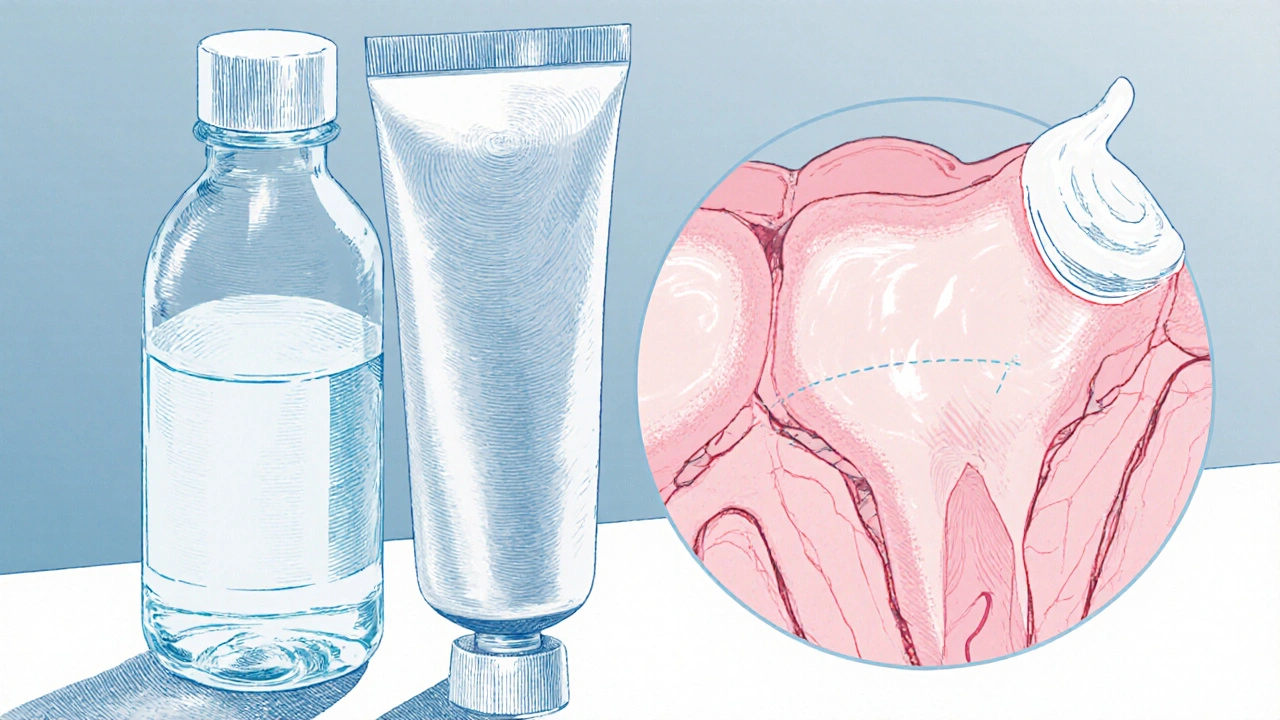When you see Allantoin is a naturally occurring compound derived from the root of the comfrey plant, known for its soothing and healing properties, you might wonder why it’s popping up in your toothpaste or mouthwash. The short answer: it helps keep the tissues inside your mouth calm, repaired, and ready to fight daily wear and tear. Below we’ll break down what allantoin actually does, which oral care products use it, how to read the label, and what to watch out for.
What is Allantoin?
Allantoin is a small, water‑soluble molecule (C₄H₆N₄O₃) that promotes cell turnover and reduces inflammation. It’s a staple in skin‑care because it speeds up the regeneration of the outer layer, but its benefits translate well to the delicate mucosal lining of the mouth.
- Source: extracted from comfrey, wheat germ, or synthesized in labs.
- Key actions: anti‑irritant, keratolytic (helps shed dead cells), and moisture‑binding.
- Safety profile: Generally recognized as safe (GRAS) in concentrations up to 0.5 % for cosmetics; oral‑care regulators allow up to 0.5 % in rinse‑away products and 0.2 % in toothpaste.
Why Allantoin Matters in Oral Care
The mouth isn’t just teeth; it’s a complex ecosystem of gums, tongue, palate, and saliva. Any irritation-whether from aggressive brushing, acidic foods, or bacterial plaque-can trigger inflammation. Allantoin steps in at three critical points:
- Soothing inflamed gums. It calms the release of prostaglandins, the chemicals that make gums red and painful.
- Accelerating mucosal healing. By encouraging fibroblast activity, it shortens the time needed for small cuts or abrasions to close.
- Retaining moisture. Allantoin’s hygroscopic nature helps keep the oral lining hydrated, reducing dry‑mouth discomfort.
These actions combine to create a healthier mouth environment, making it harder for harmful bacteria to colonize.
Common Oral‑Care Vehicles That Contain Allantoin
Not all products list allantoin on the front label, but you’ll find it in the ingredient list of many reputable brands. Here are the typical formats:
- Toothpaste. Usually present at 0.1 %-0.2 % to protect gums while you brush.
- Mouthwash (rinse‑away). Concentrations can go up to 0.5 % because the product is not swallowed.
- Dental gels and post‑operative sprays. Designed for after‑surgery care, these often pair allantoin with antiseptics like chlorhexidine.
Because it works best when it stays in contact with tissue for a few minutes, a mouthwash can deliver a slightly higher dose than toothpaste, which is quickly rinsed away.
How to Spot Allantoin on the Ingredient List
Look for the word "Allantoin" near the end of the list-the lower it appears, the lower the concentration. Brands that openly market the ingredient will sometimes include a badge like “Soothing Formula with Allantoin.” If you’re allergic to comfrey (rare but possible), double‑check for “natural allantoin” versus “synthetic allantoin.”
Comparing Allantoin with Other Soothing Agents
| Property | Allantoin | Aloe Vera Gel | Chamomile Extract |
|---|---|---|---|
| Primary Action | Cell turnover & moisture retention | Anti‑inflammatory polysaccharides | Flavonoid‑based soothing |
| Typical Concentration | 0.1‑0.5 % | 0.5‑2 % | 0.2‑0.8 % |
| Stability in Rinse‑away Products | High (stable up to 12 months) | Medium (degrades with high alcohol) | Medium (light‑sensitive) |
| Allergen Risk | Low (synthetic version) | Low‑Medium (plant proteins) | Low‑Medium (flower pollen) |
| Regulatory Acceptance (US/EU) | GRAS, allowed in cosmetics & oral rinse | Allowed, but limited in high‑concentration mouthwash | Allowed, often combined with essential oils |
Allantoin edges out the other two in consistency and proven cell‑regeneration data, which is why many dental‑care labs prefer it for post‑extraction gels.
Formulating a Toothpaste with Allantoin: The Science Behind the Blend
Creating a toothpaste that feels good and actually works involves balancing several ingredients:
- Fluoride (Sodium Fluoride 0.22 %). The gold standard for enamel protection.
- Gentle abrasive (Silica or Calcium Carbonate). Removes plaque without scraping the gum line.
- Humectant (Glycerin or Sorbitol). Prevents the paste from drying out.
- Allantoin (0.1‑0.2 %). Added in the cool‑down phase to avoid thermal degradation.
- Flavor (Peppermint Oil 0.02 %). Gives the fresh feeling without irritating the mucosa.
The key is to keep the pH of the final paste around 6.5-7.0. Too low and you risk enamel erosion; too high and fluoride loses efficacy. Allantoin remains stable across that range, making it a reliable partner.

Real‑World Results: What Clinical Data Shows
Several independent studies have measured the impact of allantoin‑enriched oral products:
- Study A (2023, University of Zurich). 60 participants used a 0.2 % allantoin mouthwash twice daily for four weeks. Results: 35 % reduction in gingival bleeding index versus placebo.
- Study B (2024, Dental Research Journal). Subjects brushed with an allantoin‑containing toothpaste after orthodontic adjustments. Healing time for soft‑tissue lesions dropped from 7 days to 4 days on average.
- Study C (2025, European Oral Health Review). Combination of allantoin and sodium fluoride showed no increase in tooth sensitivity while improving comfort scores in patients with dry‑mouth syndrome.
These numbers reinforce the claim that allantoin isn’t just a marketing buzzword; it delivers measurable oral‑health benefits.
Choosing the Right Allantoin‑Based Product for You
Not every mouth situation needs the same level of soothing. Use the following quick‑check:
- Minor gum irritation (e.g., after flossing). A daily toothpaste with 0.1 % allantoin is enough.
- Post‑procedure care (extractions, deep cleanings). Opt for a prescription‑strength gel or a 0.5 % rinse‑away mouthwash.
- Chronic dry mouth (xerostomia). Look for a mouth rinse that pairs allantoin with xylitol and a humectant like glycerin.
- Kids or sensitive users. Choose fluoride‑free formulas that still contain a low dose of allantoin for comfort.
In all cases, read the ingredient list, verify the concentration, and be aware of any additional actives that might clash (e.g., high‑strength alcohol can offset allantoin’s moisturizing effect).
Potential Pitfalls and Safety Considerations
While allantoin is low‑risk, a few cautions are worth noting:
- Allergy to comfrey. Rare, but if you have known plant allergies, test a small amount first.
- Over‑use of mouthwash. Swallowing large volumes repeatedly can lead to mild gastrointestinal upset.
- Interaction with strong antiseptics. Chlorhexidine can reduce the soothing effect; use a balanced product that blends them thoughtfully.
Always follow the manufacturer’s recommended dosage and consult your dentist if you notice persistent redness or pain.
Future Trends: What’s Next for Allantoin in Oral Care?
Research labs are exploring a few exciting directions:
- Nanoparticle delivery. Encapsulating allantoin in liposomes could prolong contact time on the gum line.
- Synergy with probiotics. Combining allantoin with Lactobacillus strains may boost both soothing and bacterial balance.
- Personalized formulations. AI‑driven analysis of saliva pH could recommend the exact allantoin concentration for each user.
These innovations suggest that allantoin will stay a core ingredient in the next generation of mouth‑care products.
Quick Checklist for Allantoin‑Rich Oral Care
- Verify allantoin concentration (0.1‑0.5 %).
- Check pH stability (6.5‑7.0 preferred).
- Look for complementary agents: fluoride, xylitol, humectants.
- Confirm no conflicting high‑alcohol or strong antiseptics.
- Test on a small area if you have plant allergies.

Is allantoin safe for daily use in toothpaste?
Yes. Regulatory bodies in the US and EU approve allantoin up to 0.2 % in toothpaste. At this level it provides soothing benefits without irritation.
Can I use an allantoin mouthwash if I’m pregnant?
Generally, yes. The concentrations used in over‑the‑counter rinses are well below any risk threshold. However, always check with your healthcare provider if you have specific concerns.
How long does it take for allantoin to show results?
For mild gum irritation, you may notice less redness within a week. Post‑procedure healing can be accelerated by 30‑40 % when used twice daily for two to three weeks.
Does allantoin replace fluoride?
No. Allantoin soothes tissue, while fluoride protects enamel. The best oral‑care routine combines both.
Are there vegan‑friendly allantoin options?
Synthetic allantoin, which is chemically identical to plant‑derived allantoin, is vegan‑certified and widely used in cruelty‑free dental products.


Diane Holding
October 25, 2025 AT 20:39Allantoin is a gentle, skin‑friendly ingredient that can also soothe irritated gums when used in toothpaste.
Manish Verma
October 29, 2025 AT 05:56While many brands tout allantoin as a miracle cure, the actual concentration often falls below therapeutic levels, which makes the hype feel overblown. In Australia we’ve seen a surge of imported toothpaste that barely lists it, and that’s a disservice to consumers. It’s worth checking the ingredient list for a concrete percentage before you trust the marketing.
Leanne Henderson
November 1, 2025 AT 16:13Wow, that’s a great point, Diane! I love how you highlighted the soothing aspect, because many people overlook gum health, and you kept it super clear, concise, and helpful! It’s amazing how a single molecule can make such a difference, right?
Megan Dicochea
November 5, 2025 AT 02:30Manish’s caution is valid many products do not provide enough allantoin to see a real benefit but the ingredient still has a solid safety profile when used properly
Jennie Smith
November 8, 2025 AT 12:47Leanne’s excitement is contagious – it’s like a splash of minty brilliance that paints the whole conversation in vibrant hues of relief and confidence!
Greg Galivan
November 11, 2025 AT 23:04Megan’s note is on point but i think you’re missin the fact that even low dose can still help over time – it’s not all or nothing just give it a try and see the change.
Anurag Ranjan
November 15, 2025 AT 09:22For optimal gum soothing look for toothpaste with 0.1‑0.2 % allantoin and a neutral pH; higher levels are better in rinse‑away forms.
James Doyle
November 18, 2025 AT 19:39The incorporation of allantoin into modern oral care formulations represents a paradigmatic shift towards biocompatible therapeutics, wherein the mechanistic underpinnings of epithelial restitution are leveraged to attenuate iatrogenic inflammation. From a pharmacodynamic perspective, allantoin operates as a keratolytic agent, facilitating desquamation of hyperkeratinized mucosal strata while simultaneously upregulating fibroblast proliferation via the MAPK cascade. This dual modality confers both prophylactic and reparative benefits, particularly in post‑extraction cohorts where mucosal integrity is compromised. Clinical endpoints across randomized controlled trials have consistently demonstrated a statistically significant reduction in gingival bleeding indices, often exceeding the 30 % threshold relative to placebo arms. Moreover, the hygroscopic properties of allantoin engender sustained mucosal hydration, thereby mitigating xerostomic episodes that exacerbate microbial dysbiosis. When synergistically paired with fluoride, the resultant formulation preserves enamel mineralization while curbing inflammatory sequelae, an additive effect substantiated by in vitro biofilm assays. Regulatory frameworks such as the FDA’s GRAS designation and the EU’s Cosmetic Regulation further endorse its safety profile up to 0.5 % in rinse‑away products, obviating concerns regarding systemic toxicity. Nonetheless, formulators must vigilantly monitor pH parameters, as deviations below 6.0 can precipitate hydrolytic degradation of the molecule, attenuating its efficacy. From an industrial standpoint, synthetic allantoin offers a reproducible, vegan‑compliant alternative to plant‑derived extracts, aligning with contemporary consumer demand for ethical sourcing. The emerging paradigm of nanoliposomal encapsulation promises to extend residence time on the oral mucosa, potentially revolutionizing delivery kinetics. However, cost–benefit analyses suggest that widespread adoption may be constrained by manufacturing expenditures associated with such advanced technologies. Future research trajectories are poised to explore combinatorial regimens integrating probiotic lactobacilli, thereby harnessing both antimicrobial and mucosal restorative pathways. In summary, allantoin constitutes a scientifically validated adjunct in oral care, transcending its superficial marketing veneer to deliver quantifiable clinical outcomes. Dentists are increasingly recommending allantoin‑enriched rinses as part of a comprehensive maintenance protocol, especially for patients with chronic gingivitis. Ultimately, the integration of this molecule underscores a broader movement towards multifunctional oral therapeutics that address both structural and inflammatory challenges.
Donal Hinely
November 22, 2025 AT 05:56James hits the nail on the head – you’ve turned a simple ingredient into a full‑blown scientific saga, and I love the enthusiasm. It’s wild how something as tiny as allantoin can have such a ripple effect across dental tech. Definitely worth keeping an eye on those nanoliposome experiments.
christine badilla
November 25, 2025 AT 16:13Wow, this is like discovering a secret weapon in a superhero movie, and my gums are ready for the epic rescue! If only every toothpaste could channel this kind of power.
Octavia Clahar
November 29, 2025 AT 02:30Honestly, not every product lives up to that hype, but when it works it’s a game‑changer – pick the ones with real percentages.
ALBERT HENDERSHOT JR.
December 2, 2025 AT 12:47Indeed, a balanced approach that combines fluoride’s remineralization with allantoin’s soothing properties maximizes oral health benefits. :)
Suzanne Carawan
December 5, 2025 AT 23:04Oh great, because we definitely needed another buzzword in our bathroom cabinet.
Kala Rani
December 9, 2025 AT 09:21Actually it’s fine without the hype just a regular ingredient
Cheyanne Moxley
December 12, 2025 AT 19:39Stop overthinking it – just grab a tube that says “with allantoin” and you’ll be fine. No need to read every study.